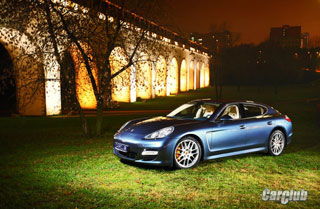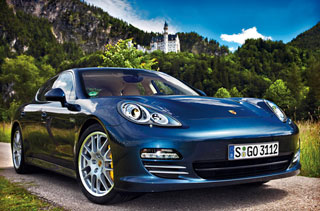Porsche Panamera test drive since 2009 hatchback
Migration of the soul
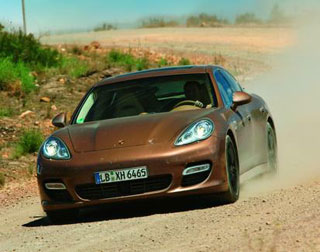 In those moments when you read this article, Lamborghini and Jaguar, Bugatti and Aston Martin, Ferrari and Fisker in the sweat of faces work on 4-door supercars. We have to state the controlled fact that Porsche was ahead of all of them
In those moments when you read this article, Lamborghini and Jaguar, Bugatti and Aston Martin, Ferrari and Fisker in the sweat of faces work on 4-door supercars. We have to state the controlled fact that Porsche was ahead of all of them This is not the first attempt by the heirs of Ferdinand Porsche to replenish your production program with a super -steering luxury sedan. Back in the mid-80s, the team of engineers led by Ulrich Bets, the future chef Aston Martin, began testing prototypes built on the basis of anthramotor model 928. A little later, marketing considerations forced the Germans to go in a more difficult way, choosing Porsche 911 as a donor. And In 1991, they showed the public a concept car at number 989, which in fact turned out to be an elongated version of 911 with an additional pair of doors. Two decades later, Panamera appeared, which absorbed the experience of early developments: preserving the style of the 911 family, it inherited the front location of the power unit in the 928th.
So take and stretch the 2-door Porsche 911? This could not be discussed! Michael Mauer, Porsche AG, chief designer, is surprised at the naivety of journalists. The technical director of the project Michael Steiner talks about something else: Panamera definitely carries the 911st genes. And where, allow me to be inquire, truth? By the way, these gentlemen do not contradict each other, what we were convinced, joining the elite group of factory testers who are engaged in bringing the running qualities of the new sedan to mind in South Africa.
Higher Judge
Having occupied all four separate chairs of the car, we quickly came to the conclusion that it was simply created to transport business travelers or families with two children at marathon distances. The trunk lid electric drive opens access to a cargo compartment with a capacity of 432 liters, devoid of partition, which would separate it from the passenger salon. So, Panamera can transport fairly large objects. Have you thought about building materials? God forbid! It was about something really valuable, for example, about the beloved Irish wolfhound. The backs of the rear seats, along with a wide middle armrest, easily fold, forming an extensive surface that extends to the front seats. It turns out that Panamera is not a sedan, but a real hatchback? That's the news! By the way, in a recent car history, a car flashed, strikingly similar to a new Porsche. Rather, on the contrary. This is Bugatti EB112, collected in several copies. That was the real sedan, with a separate trunk! But enough about EB112 Herr Mauer may be offended.
 And what if Panamera call an ersatz universal? Universal?! Well, well, shaking his head barely noticeably, Michael Steiner smiles. Having accelerated, he throws the car in a steep turn, and then releases the accelerator to go straight to the limit of the adhesive capabilities of the tires. When was the last time you had a chance to drive a station wagon with a similar temperament? And I understand that I blurted out nonsense. This is not a station wagon! For the needs of strong business executives, Cayenne is produced, to which Porsche is generally specific in Porsche.
And what if Panamera call an ersatz universal? Universal?! Well, well, shaking his head barely noticeably, Michael Steiner smiles. Having accelerated, he throws the car in a steep turn, and then releases the accelerator to go straight to the limit of the adhesive capabilities of the tires. When was the last time you had a chance to drive a station wagon with a similar temperament? And I understand that I blurted out nonsense. This is not a station wagon! For the needs of strong business executives, Cayenne is produced, to which Porsche is generally specific in Porsche. Deep leather chairs with an impeccable profile are constructively identical in that they are installed on the 911th. Planting seems extremely low from the asphalt Panamera only 30 mm further than the main shrine of the German brand. There is no other such machine in the world. Our strategic goal was to arrange a driver 20 mm lower than in any of the competing machines, says Steiner. And in competitors there are serious players such as Mercedes-Benz CLS 63 AMG and Maserati Quattroporte.
Having hit the wheel, you find yourself in a well -known environment. The Panamera interior is a thorough cast with the 911th, copying ergonomics, design and many details, up to mirrors and door handles. The geometry of the driver’s place, the mutual arrangement of governing bodies and efforts on them are reproduced one to one: in other words, he sat down and went. Naturally, you could not figure it out a little later with innovations without them. The readings of the devices are overloaded with symbols of an additional information display located to the right of the tachometer. The driver and his neighbor is shared by the flowing central console, previously already found on the Carrera GT model. Its structure with diagonal notches of buttons causes associations with Vertu phones. Favorable associations, rich. Low landing, a powerful console on the right and a high window line on the left create the illusion of piloting a business jet, which are controlled by Porsche 911. In general, Panamera’s potential customers are presented competently, regardless of which part of the cabin the future owner intends to live.
The rear passengers are awaiting a real surprise. From Panamera, despite the abundance of doors, first of all, everyone is waiting for half -fainting accelerations, and not a record capacity. Such machines are traditionally friends with aerodynamics, without hesitation, making functionality to the sacrifice of the form and making the driver the central figure to the detriment of the rest of the riders. In any case, it was believed to be so until Panamera appeared. From now on, everything is different. The second row of seats is ready to accept passengers 190 cm tall, leaving a tangible supply of space over their heads. They say that because of this, a conflict arose between designers, engineers, technologists and marketers, in which the chapter Porsche AG Vendelina Videking had to intervene. The boss made Solomonov’s decision to increase the overall length of the machine by 20 mm, personally approving one of several options for the profile of the sloping roof. These events occurred on the eve of the point of non -return, when no changes would be impossible without a fatal failure in working graphics.
 Michael Mauer admits that he did not experience a special surge of joy then he had to simply obey, although he deeply respects Videking for courage and determination. So, we now know who to thank or blame for the fact that the rear passengers are sitting in the 5-meter Panamera almost on the ground, extending their legs, like in Mercedes S-Class. We have already said that separate chairs were installed in the second row, between which an impressive transmission tunnel runs. They are equipped with an impressive set of electrical adjustments, heating and ventilation. Everything is like in the best houses of Stuttgart and Munich! The back of the cabin is illuminated by hidden illumination, a folding table for a laptop is integrated into the armrest. The kit includes a control panel of the right front seat and an audio system and, of course, a four-zone climate control. The central console, which smoothly loses its monumental height on the approach to the trunk, in combination with deep chairs creates a feeling of comfort and inviolability.
Michael Mauer admits that he did not experience a special surge of joy then he had to simply obey, although he deeply respects Videking for courage and determination. So, we now know who to thank or blame for the fact that the rear passengers are sitting in the 5-meter Panamera almost on the ground, extending their legs, like in Mercedes S-Class. We have already said that separate chairs were installed in the second row, between which an impressive transmission tunnel runs. They are equipped with an impressive set of electrical adjustments, heating and ventilation. Everything is like in the best houses of Stuttgart and Munich! The back of the cabin is illuminated by hidden illumination, a folding table for a laptop is integrated into the armrest. The kit includes a control panel of the right front seat and an audio system and, of course, a four-zone climate control. The central console, which smoothly loses its monumental height on the approach to the trunk, in combination with deep chairs creates a feeling of comfort and inviolability. Full forward
As happens with journalists, we were put in a top version that carries the laconic name Panamera Turbo. It is driven in motion with a booster V-shaped eight with a volume of 4.8 liters, a pair of which is a 7-speed pre-sequential transmission PDK with two clutches an extremely massive unit that influenced the entire layout of the machine. The drive is complete, and the torque is transmitted to the front axis through a multi -disc couple with electronic control. There are four modifications in total: the base C V6 and the drive to the rear wheels, Panamera S with atmospheric V8 and again by the rear-wheel drive, 4S with the same engine, but already two leading axes and, finally, our Panamera Turbo with a pleasant power of half a horsepower . True, the hegemony of the Turbo phenomenon is temporary that people from Porsche are semi -official: in the future there will be cars and hotter. And the first modifications S and 4S, equipped with a 400-horsepower V8 with direct injection, will happen to the market, this will happen in June of this year. A 6-speed mechanical box is considered standard equipment, and as an alternative it is offered PDK, borrowed from the updated 911th.
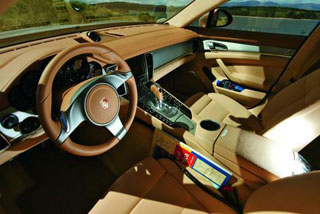 The positive point of Panamera Turbo is that all equipment that selectively requires surcharges is sewn into its base. In particular, this is an active PASM (Porsche Active Suspension Management) with three work modes: Normal, Sport and Sport Plus. Or the PDCC rejuvenation system (Porsche Dynamic Chassis Control), which was previously tested on Cayenne and proven itself excellently. However, even in the Normal Panamera Turbo position, it goes noticeably tougher than Mercedes-Benz S-Lass, although more neat than the Maserati Quattroporte Sport GTS recently experienced. In Sport mode, shock absorbers and the steering wheel pass on the driver by an order of magnitude more accurate information about the road situation. By the way, in a quick turn, he better feels the approach of the moment of disruption of the front wheels in sliding. Porsche experts say that ambitious drivers will give preference to this regime, who are not frightened by the more rough operation of the suspension and transmission, if it exacerbates the reaction of the machine and reduces the rolls of its body. As for the position of Sport Plus, it is recommended for the choice, when only the driver is in the car, and the car itself is on the racing track. In the worst case, on the autobahn. Then Panamera acquires habits inherent in 911 Carrera. In short, get ready for shocks when shifting gears, races on all bumps in a row and roar of the motor, pressing the tachometer to the red zone. Nevertheless, the increased mass and a long wheelbase give Panamera a little of flexibility.
The positive point of Panamera Turbo is that all equipment that selectively requires surcharges is sewn into its base. In particular, this is an active PASM (Porsche Active Suspension Management) with three work modes: Normal, Sport and Sport Plus. Or the PDCC rejuvenation system (Porsche Dynamic Chassis Control), which was previously tested on Cayenne and proven itself excellently. However, even in the Normal Panamera Turbo position, it goes noticeably tougher than Mercedes-Benz S-Lass, although more neat than the Maserati Quattroporte Sport GTS recently experienced. In Sport mode, shock absorbers and the steering wheel pass on the driver by an order of magnitude more accurate information about the road situation. By the way, in a quick turn, he better feels the approach of the moment of disruption of the front wheels in sliding. Porsche experts say that ambitious drivers will give preference to this regime, who are not frightened by the more rough operation of the suspension and transmission, if it exacerbates the reaction of the machine and reduces the rolls of its body. As for the position of Sport Plus, it is recommended for the choice, when only the driver is in the car, and the car itself is on the racing track. In the worst case, on the autobahn. Then Panamera acquires habits inherent in 911 Carrera. In short, get ready for shocks when shifting gears, races on all bumps in a row and roar of the motor, pressing the tachometer to the red zone. Nevertheless, the increased mass and a long wheelbase give Panamera a little of flexibility. The distribution of weight along the axes (52:48 in favor of the front line) has a fateful effect on the behavior of the car in corners. Panamera responds to the dashing gas handling to the possible development of skidding, but the stabilization system gently and confidently leads the car along the trajectory, at first glance, without correcting the driver’s actions. It seems to a person that he and only he commands the car. Phenomenal! The brake performance is still magnificent, they migrated here directly with 911 Turbo, and that’s it. PCCB (PORSCHE CERAMIC Composite Brake) brakes made of cermaramics is twice as light as standard steel, and last six times longer. On the highway, they work miracles: Steiner promises that a distance of less than 40 m is required to stop 100 km/h. If you are looking for the perfect balance between controllability, smoothness and noise level, you should order 19-inch wheels, he franks. Perhaps, with discs of the 20th size, Panamera looks elegant, but the car will not go faster.
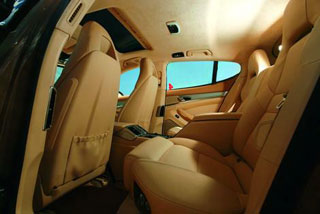 And only the Sport Plus mode breaks the veil of secrets from the true capabilities of the car. In the I transmission, the engine is twisted to the ringing, the box pulls the car, and the engine immediately rests on the limiter, but already on II with such an unreal density, a series of events is compressed! That is why the Porsche 911 genes seemed to Steinra! Despite the excess mass and burly physique, Panamera shows such a fighting spirit that no unknown sedan of the comparable class is unknown to the accelerator's response is ahead of desires, the steering wheel is more acute than the scalpel, and the case is barely fired when the low -profile tires draw black markings in the bends.
And only the Sport Plus mode breaks the veil of secrets from the true capabilities of the car. In the I transmission, the engine is twisted to the ringing, the box pulls the car, and the engine immediately rests on the limiter, but already on II with such an unreal density, a series of events is compressed! That is why the Porsche 911 genes seemed to Steinra! Despite the excess mass and burly physique, Panamera shows such a fighting spirit that no unknown sedan of the comparable class is unknown to the accelerator's response is ahead of desires, the steering wheel is more acute than the scalpel, and the case is barely fired when the low -profile tires draw black markings in the bends. If your nervous system does not cope with such an avalanche of emotions, return to more calm modes. Just keep in mind that the Normal is also a kind of extreme: the 8-cylinder engine lazily swims in the low-speed zone, the PDK gracefully jugles with numbers from 1 to 7. On the highway, the mighty biturbomotor remains in the range of 12002000 rpm 1200 rpm at the VII program corresponds to 80 km/h, and 1900 increase speed to 130 km/h. One bad thing: in the interval between 1400 and 1900 rpm somewhere in the back of the cabin, low-frequency pulsations arise, partially getting rid of which the stretched trunk curtain helps. According to testers, this problem arises only on the Turbo version.
It happens that the driver gets under the tail, and he just likes, for the sake of abruptly presses the gas. Well, or in the case, for example, for overtaking a string of weaving machines. The box requires milliseconds to use the transmission on the III in advance, and in the blink of an eye the engine jumps from 2000 to 4500 rpm. Four wheels with rage bite into the asphalt, and the passengers caught by surprise spread together along the backs of the seats. However, in comparison with 911 Carrera, the ennobled Panamera is not inclined to acoustic terrorism, its motor compartment is excellently soundproof, and the voice of the power unit is heard as if from under a thick blanket. Fortunately, Porsche knows the needs and aspirations of its fans, so there is a cunning button on the central console, which opens in the exhaust system the bypass valve. The salon is immediately filled with thick bass, in which a metal hoarse appears with an increase in revolution. Here it is, the moment of ecstasy for any sophisticated connoisseur Porsche 911 is all its own, all the present!
 Like any self -respecting sports car of our time, Panamera has acquired the Launch Control function, which provides maximum acceleration at starting. The engine at once throws a colossal torque on the drive wheels, and the electronics suppresses the slip. To implement the function, the driver must go to Sport Plus mode, and then squeeze the gas and brake pedals at the same time. As soon as the motor gains 4500 rpm, the brake can be released. For a moment, the entire potential of the engine collapses onto the wheels, but only in order to warm up the tires, then the electronics reduces the speed, and acceleration begins on the verge of slipping. The pre -sequent transmission guarantees the inextricability of the power flow, opening the straight road to the speedy ceiling. On the free segment of the autobahn, we managed to reach 330 km/h, recalls Michael Steiner. In the place of rivals, I would cringe
Like any self -respecting sports car of our time, Panamera has acquired the Launch Control function, which provides maximum acceleration at starting. The engine at once throws a colossal torque on the drive wheels, and the electronics suppresses the slip. To implement the function, the driver must go to Sport Plus mode, and then squeeze the gas and brake pedals at the same time. As soon as the motor gains 4500 rpm, the brake can be released. For a moment, the entire potential of the engine collapses onto the wheels, but only in order to warm up the tires, then the electronics reduces the speed, and acceleration begins on the verge of slipping. The pre -sequent transmission guarantees the inextricability of the power flow, opening the straight road to the speedy ceiling. On the free segment of the autobahn, we managed to reach 330 km/h, recalls Michael Steiner. In the place of rivals, I would cringe Eco -position
All modifications of the Panamera model are seriously equipped with the Start/Stop system, which independently disconnects the engine when stopping in a traffic jam or at a traffic light. This saves fuel and, as a result, reduces the toxicity of the exhaust. For the first time in world practice, such a system was used for machine with an 8-cylinder engine and automatic (more precisely, automated) KP. It led to the use of an integrated starter-generator and piston position sensors, which are designed to make the subsequent launch of the motor as soft as possible. The system launches the engine as soon as the driver releases the brake, and, according to the assurances of Porsche representatives, their Start/Stop is swimmer than all analogues available on the market.
The widespread use of light materials illustrates the seriousness of Porsche's intentions to bring Panamera closer to driving qualities with sports cars. The outer doors and hood panels are made of aluminum, it is also widely used in the suspension. Amplifiers of the doors and front bumper made of magnesium alloy. All the details that are located in the front overhang are made of light materials. All without exception, Steiner explains. All this helped to keep the mass of the Turbo version with its heavy engine, all-wheel drive transmission and PDK within 2 tons. Today, the version with the V8, rear-wheel drive and 6-speed manual transmission showed the result of 1770 kg. Thus, the specific power was 4.4 kg/hp.
The eternal problem of searching for the optimal ratio between the effective distribution of running air flows and a stable clutch of wheels with the road was solved using the original aerodynamic package. At Panamera Turbo, it is built around a three-dimensional spoiler, which automatically leaves the rear window after reaching 80 km/h, but up to 180 km/h remains in an ecostalist, that is, a half-frustrated state. Then the spoiler spreads to the sides, creating an additional clamping force. At a speed of 250 km/h, the aerodynamics loads the rear wheels with a force of 270 N, says Steiner. This is comparable with a mass of beer box located in the trunk. This is the merit of not only a three -dimensional spoiler, but also competent control of the movement of air outlets under the bottom of the car.
Panamera is difficult to classify as carriers of revolutionary technologies, which is considered the BMW 7th series, or to guarantors of complete security like Mercedes S-Slass. He is unlikely to have manic sports, which Maserati Quattroporte Sport GTS surprised us a lot. It will be the most fairly to talk about a successful attempt to transplant exemplary manners Porsche 911 a larger 4-door sedan let it be a sedan in the end. The triumph of native engineering!
We became aware that the factory pilot Walter Rerle has already stormed the northern loop of Nürburgring while driving Panamera Turbo. The Germans keep his result a secret, but pride forced them to blame. So, Panamera was faster than all sedans that used to go to the legendary ring. Moreover, according to Steiner, the position of the sedan in the absolute standings, where supercars unconditionally dominate, will be a real revelation for everyone. Give the numbers!
Jurgen Cellter
Photo by the author and the manufacturer
Source: Avtopanorama magazine




